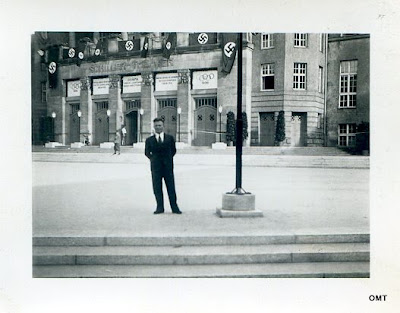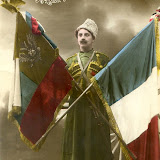Postcards of actresses from the Weimar cinema
JG: “You’re Norma Desmond. You used to be in silent pictures. You used to be big.”
ND: “I am big. It’s the pictures that got small.”
Sunset Boulevard, 1950

According to standard histories the sudden explosion of inspired creativity that was Weimar cinema was snuffed out when Hitler came to power, but the Nazis probably delivered the coup de grâce rather than the first mortal blows. Its genius lay in silent films and although the years between the introduction of sound and Hitler’s anointment as Chancellor are too brief to make a definitive statement, nothing close to the two masterpieces that really bookended Weimar cinema – The Cabinet of Dr Caligari (1920) and Metropolis (1927) - was produced in the early sound era. By the end a lot of actors, directors, screenwriters and cinematographers had moved to Hollywood, for economic rather than political reasons. Others couldn’t adjust to the new technology of sound. If the various influences that German émigrés brought to American cinema could be distilled into a single phrase it would be that they made Hollywood grow up. Without the worldly moral reasoning of people like Fritz Lang and Marlene Dietrich, Disneyland need not have been created because it already existed.
Some actresses stayed behind. Underneath the constructed glamour of stardom there is a study in the way people resisted dictatorship. At a time when no one could be openly defiant, some preserved their integrity by playing safe; others were prepared to put their lives on the line. Quite a few represented here emigrated, which, if anyone could do that, was both logical and wise. Most have been long forgotten. Even their films are lost. These photo postcards, published by the Ross Verlag company among others, are our most tangible link to some of these women.
Vilma Banky
Son of the Sheik hasn’t aged well but everyone knows the image of Vilma Banky swooning in the arms of the be-robed Rudolph Valentino. Most of the films she made in Budapest and Berlin have been lost. In 1926 she signed a contract with Samuel Goldwyn and left for America, where she acted with Ronald Colman in a few films before meeting Valentino. She died in 1991, aged 92 but her death wasn’t announced for another year.
Pola Negri
Asked in 1978 if she had been responsible for introducing sex into the cinema, Negri assured the interviewer that was correct though pointed out that in her films it had always been left to the imagination. Born in Poland, she made her first film there in 1914. In 1918 she began working with the German director Ernest Lubitsch, notably as the lead in two silent epics, Carmen and Madame du Barry. Moving to Hollywood in 1923, her popularity as a silent film actress grew though she is probably best known today as the last great love of Rudolph Valentino. She returned to Europe in the 1930s to make a few films, leaving finally when Germany invaded France. Despite affairs with other men and women, her reputation as a sex siren was mostly a cinematic invention. Before she died in 1987 aged 90 she left endowments to several American universities and arts centres.
Lil Dagover
Damned if you do, damned if you don’t. Being anointed as Hitler’s favourite actress has inevitably led some to wonder how sympathetic Dagover was to him, though she was not obliged to reciprocate his opinions. The films she made during and after the war tended to be safe and forgettable but in the 1920s she had been one of the stars of expressionist cinema, mot notably playing Jane, Francis’ fiancée in The Cabinet of Dr Caligari (1920). She also starred in Fritz Lang’s Destiny and Dr Mabuse; the gambler and F W Murnau’s The Phantom (all1922). She continued to act in German television and occasionally in cinema into her nineties.
Grafin Agnes Esterhazy
Agnes Countess of Josika Branyitska, a descendent of Elizabeth Bathory, was born in Transylvania and began acting in Budapest and Vienna in the early 1920s. In Berlin her best known role probably was as a prostitute alongside Greta Garbo in G W Pabst’s Joyless Street (1925). Consciously rejecting the lavish visual elements of expressionism, the film was an attempt at social criticism during the period of hyper-inflation. Esterhazy was one actress who could not make the passage to sound film and had more or less retired by the early 1930s.
Brigitte Helm
If a single scene epitomized Weimar cinema, it was the moment when Maria, the saintly champion of the underground workers, was transformed into a robot in Fritz Lang’s Metropolis. It is the point when none-too-subtle allegories about humanity and the machine, technical virtuosity and the visual trademarks come together. It was also 19 year old Brigitte Helm’s first film and apparently she hated the ordeal. She acted in some 29 further films and was a star throughout Europe, but when the Nazis took control of the UFA Studios in 1935 she quit in protest and moved to Switzerland then Italy. She died in 1990, repeatedly turning down interviews and offers to return to the cinema.
Lya Mara
Despite being described as a major star of German silent films and an abundance of images of her, information about Lya Mara is scarce. Even the date and circumstances of her death are unknown. It is on record that she was born in Latvia, that she wanted to study chemistry until her father’s death made the cost of the required education prohibitive and that she took up ballet. In the late 1920s she was involved in a serious car accident – again, no details – and that she only made one sound film, suggesting that like a lot of actors she couldn’t make the transition. Like Brigitte Helm, she quit her acting career when the Nazis came to power, emigrating to London with her husband, the film director Frederic Zelnik. Thereafter the trail goes cold. There’s a hint in these spare facts of disappointment and thwarted ambition but that can only be speculation.
Lya de Putti
These days all the silent film actresses have been labelled vamps but Pola Negri’s claim to have introduced sex into cinema may have met with a sniff of derision from Lya de Putti. As the photo of her stretched out of the sofa, her top unbuttoned, party balloons in the air, and surviving scenes from her films suggest, she didn’t waste time leaving things to the imagination. Born in Hungary, she moved to Berlin during the war to act and perform in ballet. Her most famous role was as Berta-Marie, the trapeze acrobat in Varieté (1925) who becomes the destructive obsession of the circus owner. She moved to Hollywood in 1926. The titles of some of the films she made there; Prince of Tempters, Sorrows of Satan, Heart Thief, Midnight Rose, indicate she wasn’t hired to play the girl next door. She died in 1931, aged thirty two, from an infection she may have picked up in a New York hospital. Her decline and death received considerable publicity at the time though she did not inspire the wave of grief that had surrounded Rudolph Valentino. In Hollywood, femmes fatale always got their comeuppance.

Goebbels called her ‘our little dancing flea’, and he thought he was being complimentary. She did tend to play the ingénue; perhaps a silent prototype of Doris Day is more accurate, but probably no other actress put her career at such risk resisting the Nazis. She helped Jewish friends escape the country, had her bank accounts frozen and escaped, working as a nurse for the Allied forces in France. After the war she remained there, running a souvenir shop in Antibes.
Marlene Dietrich
Between 1930 and 1939 Marlene Dietrich regularly played the role of a prostitute, which may be a comment on what Hollywood producers thought of European women in general or it could be that she was better than anyone else at playing a woman with no illusions. There was a contrast between the woman on screen and in the flesh. According to her daughter, she took on George Bernard Shaw and John F Kennedy as lovers, with quite a few more in between, though she was married to the same man for nearly sixty years. During the war, when Hollywood’s Jewish producers preferred to keep their own counsel about what was happening in Germany, she was a vocal campaigner against Nazism. She had small roles in silent films in Germany between 1919 and 1929, most often playing a dancer.
Rosy Barsony
The only actress in this group publicly identified as Jewish, Rosy Barsony began working in sound films in 1931. Prohibited from working in Germany and her birthplace, Budapest, she travelled to Italy with her husband where again they were denied work. Her acting career was over by 1938.
Evelyn Holt
Beginning in the late 1920s, Holt’s earliest films were light melodramas. Trained as a singer she was able to move into sound films but her marriage to the Jewish publisher Felix Guggenheim ended her career. They moved to Switzerland and later to the US.
Camilla Horn
In 1972, when he was just another scruffy folk singer, Bruce Springsteen recorded the brief and insignificant ‘Camilla Horn’. “Camilla Horne, she was born a long, long time ago/She came from Germany to the U.S.A/and was acclaimed as the next Garbo … And so she took her place at the bar/Just another fallen star”. How much he based the last line on evidence is probably something Springsteen no longer recalls but ten years later Camilla Horn would have a small renaissance in German films and on television. In 1926 she had a major role in Murnau’s 1926 film of Faust but a film that deserves more attention was released the previous year. Ways to Strength and Beauty was a celebration of the health and vitality of the young German body and featured Horn and Leni Reifenstahl as dancers. Horn went to Hollywood and returned to Germany in the mid 1930s. She was arrested by the Gestapo and briefly jailed by the British in the months after the war.
Liane Haid
Haid played Lucretia Borgia in 1922 but was generally recognized as the sweet, virginal type. Like most of the actresses here she originally trained as a dancer, which translated easily into the physical expressiveness required for silent films. She left Berlin for Switzerland in 1942. The silent era can seem so distant now it is easy to forget that actors were usually young and a few, Helm, Negri and Dagover for example, only died in the last twenty years. Haid saw out the entire century, dying in 2000 aged 105.
VIEW THE GALLERY HERE








































